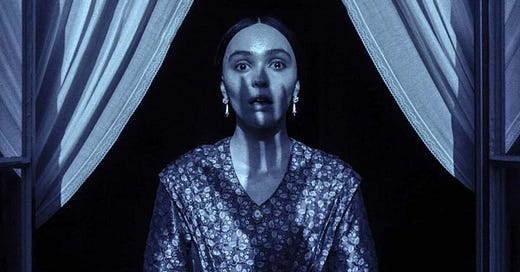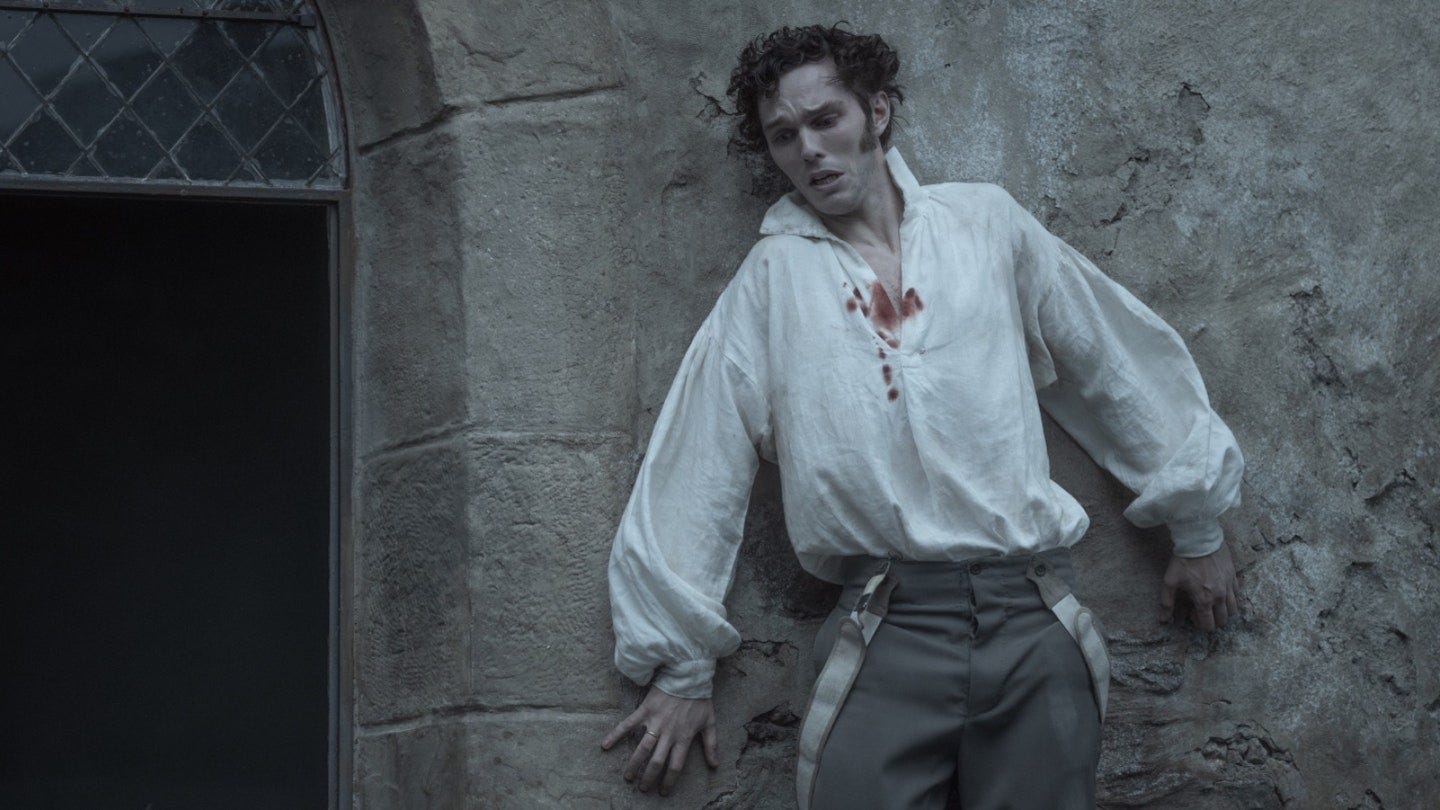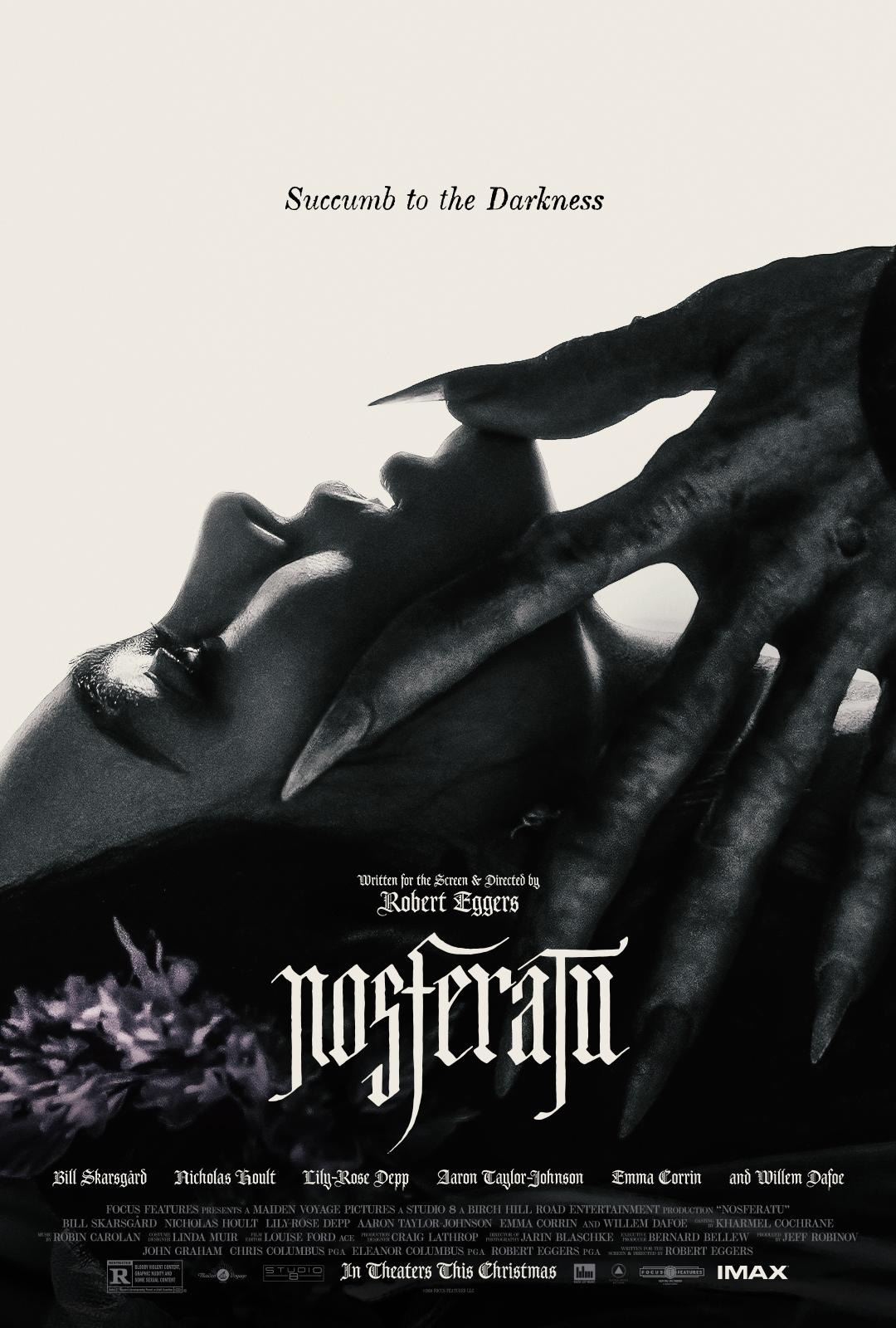I know not if we, as a species, have the language or evolutionary status necessary to talk about Nosferatu, all-encompassing of both Robert Eggers’ latest effort and the century-old horror benchmark it was reborn from. Though, perhaps the futility of intellectualizing Nosferatu is precisely why it has to exist, and subsequently why the original managed to survive Florence Stoker’s calls for its destruction.
Think about that for a second. On the order of some learned, inner sense of insignificant ownership, Florence wished for all copies of 1922’s Nosferatu to be sealed away/destroyed so that it may shrivel out of the zeitgeist with time and ignorance. And yet, Nosferatu, and all that resided in it, was an inevitability; an inevitability that led us to Eggers’ film, which plays up the dangers of sealing away one’s humanity, just as Florence tried to seal away the original so long ago.
We’ve much to discuss, folks.
The very first scene in the original Nosferatu sees Thomas Hutter pick from his garden a collection of flowers for his wife Ellen, whose immediate reaction is “Why did you kill them… such beautiful flowers…?!” Thomas hugs her, laughing it off, before it cuts to the next scene. A similar scene exists near the beginning of Eggers’ version, as deceptively unceremonious as the one in the OG Nosferatu.
It is no accident that that was the first scene in the original. Here we have a man who thinks nothing of destroying beautiful things that grow in his domain, and yet Count Orlok’s destruction of Ellen — Orlok being Death, and Ellen therefore being in his domain as every other human is — is treated as some horrific campaign.
That’s not to say it isn’t horrific. It’s one thing to draw an equivalency between ourselves and the flowers that Thomas picks insofar as we are both objects of collection (flowers by us, us by Death), but to leave it at that would be to veer into a dangerously nihilistic anti-humanism that partially originated the cosmic horror genre, which Eggers has dealt in twice now with The Lighthouse and Nosferatu.1
The quintessential genius of Eggers’ Nosferatu, however, is how it fleshes out (and arguably creates) the humanism of such an ordeal without being so naive as to offer comfort to the audience.
The terror of Nosferatu is inseparable from its beauty. Not beauty in its evocative visuals, nor in the thrill of its more transgressive material, but in the permission it gives us to excavate a mythopoeic, rapturous, alien-yet-purely human truth. This emotional truth, so often channeled by the feminine spirit, so often corrupted by fear and greed, and so often smothered by a world that grows more and more disconnected with every passing year.
Is it any wonder that Werner Herzog, a staunch advocate of esoteric truth, remade this film back in 1979?
Lily-Rose Depp’s Ellen Hutter is a vessel of this truth, and also of love for her fellow humans. She craves a bodily and spiritual freedom that only nature’s amorphous shape can provide. The so-called “nonsense” that comes out of her mouth is every bit as true as the world’s more observable components, but because hers is an emotional truth that requires a supremely uncomfortable existential surrender, those around her prefer to shame her into suppressing that truth for their own comfort. Her father was the first to do this.
This deprivation of love — real love, defined by visibility and acceptance — led Ellen to yearn for it, of course, and since she couldn’t find that in humanity/society, she turned deeper into her emotional truth. And without love, this emotional truth becomes darker, more twisted, and perhaps more cynical.
Enter Nosferatu; a manifestation of these dark, unknown spaces that Ellen so freely pulled from and transmuted until she was told not to. In Nosferatu, Ellen’s truth has found another way out, and it’s none too happy that its more benign form wasn’t welcome.
Then comes Nicholas Hoult’s Thomas. He loves Ellen, and Ellen loves him, but he either cannot or refuses to love Ellen in the way she needs to be loved. She speaks of her desires and shame, but Thomas insists that she keep those things hidden from the world. Meanwhile, he ventures off to Count Orlok’s estate (much to the dismay of Ellen) so that he can earn a whole bunch of money and a firmer foothold at the company he works at; all meaningless status indicators that run counter to what’s truly important (love, and, by extension, truth).
Thomas, you see, is too infatuated with the easy, tangible truth of society to well and truly accept what and who Ellen is. His is a prioritization of his own attachments (to Ellen’s more comprehensible aspects, and to society) rather than being a witness to Ellen’s authenticity.
In Thomas’ boss, Herr Knock (Simon McBurney) — who surrenders himself to Count Orlok and does what he believes to be the Count’s bidding by slaughtering animals and people alike — there exists a parallel with Ellen. Both Ellen and Knock are privy to the cosmic inevitability of the human plight, but where Ellen channels it from a place of love, Knock does so from a place of fear and domination, which a man of high industry like himself likely knows nothing other than.
It’s no coincidence that Knock’s industrially-saturated way of being translates to so much firsthand violence, discord, and anti-humanism when he arrives on that cosmic doorstep. His way was never natural; Ellen’s was.
Ellen, despite her very real love for Thomas, feels trapped by the world that he tries so hard to be a part of; a world that judges her truth. She wishes to be free of this (meaning the judgement, if not the world itself), but the mutual attachment between her and Thomas creates conflict with that wish.
Friedrich and Anna (played by Aaron Taylor-Johnson and Emma Corrin, respectively) flesh this conflict out even more. Anna is more receptive and accepting of Ellen’s truth, but is ultimately too entrenched in the throes of society to meet her in full, while Friedrich further unveils the debilitating, controlling nature of these societies and the conformity that they demand.
This society believes it inappropriate for Ellen to be called by the sky and ocean, yet it’s perfectly acceptable for Friedrich to impregnate Anna without her knowing. It’s no wonder Ellen seems to envy her cat Greta, who “has no master.”
Alongside character and broader storytelling, the technical components of Nosferatu also urge us to exist alongside the incomprehensible, mythopoeic aspects of our existence without trying to understand or otherwise control them. The camera drifts, tilts, and pans around the film’s landscapes and architecture, always making space for the independent movements of its subjects without disregarding its own potential for motion.
These two instances of motion do not clash with one another. The subjects exist within the frame, but make no effort to control their place in that frame. The frame itself, meanwhile, chooses to harbor a range of motion that allows the subjects to exist as freely and evocatively as they do. The camera remains the superior instance of motion, of course, but it does not treat itself as such.
This to say, we needn’t make a Nosferatu out of our existential, emotional truths by restraining/burying them for the sake of conformity. Our desire to inhabit the most carnal form of spiritual freedom can absolutely, positively be achieved through the act of love.
Love, of course, is primarily defined by allowance of being, and the act of being is notoriously suppressed by society. This camera does not suppress. It could, but it chooses not to, perhaps because it knows better.
Beyond the camera, Eggers’ decision to frequently present Nosferatu as a shadow emboldens the film’s urging to treat our emotional truths with dutiful acceptance.
The shadow does a few things. First, it nods to the silent film-era practice of having key events take place off-screen, relying on the audience to trust in its story without seeing it all. In other words, the film’s events are rendered partially intangible; suggestions we must surrender to rather than truths we can comfortably document.
Second, and more importantly, it makes a suggestion out of Nosferatu himself. This is important because, throughout the film, Nosferatu remains a threat that we audiences treat as very real, even when his presence amounts to nothing more than a shadow.2 The suggestion of Nosferatu, therefore, is every bit as real as things that we can touch and see and smell and what have you.
The question, then: When it comes to things that aren’t tangible/provable, why do we give so much power to fear? Why not give that power to unobservable love/wonder like Ellen did? Why was she forced into fear and shame with that “madness” label while the mere suggestion of Nosferatu was free to wreak havoc?
The esoteric, mythopoeic, emotional truths of this world are only respected when they manifest as threats. What might this say about how we build our more scientific, comfortably comprehensible societies? Will these social systems truly protect us from ourselves? It sure as hell didn’t protect Knock.
Also, who says we need to be protected from ourselves? Nosferatu and the plague, after all, only came about because Ellen’s emotional truth (or humanity) was suppressed by the world. Maybe honoring her hallucinations isn’t so bad. Maybe they’re not hallucinations.
The last thing I’ll say is that these emotional truths will always endure, while tangible truths never have and never will. I implore each and every one of you to harbor those truths graciously in yourself and in others, as I have a not-so-sneaking suspicion that society is going to collapse within my lifetime, and probably yours, too.
And if we then find ourselves too unaccustomed to the rawest form of our minds, bodies, spirits, and hearts, we risk letting fear take control, which is precisely how we got into this mess in the first place.
I confess I haven’t seen The Witch, so that may or may not also deal in such things.
A shadow that can open doors, which only deepens the point being made here.










I really found this movie haunting and moving, so I appreciated your thoughtful remarks on it. It still is sticking in my mind a month after seeing it. Thanks for all the time and effort that went into writing up your thoughts for us!
Nice take. I’ve been ambivalent about the absence of visible screen time Bill Skarsgård got—as in I could hardly see him. But that sort of negative space kind of works, giving the viewer their own space to fill in their version of shadow